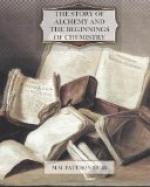What happens when a substance is burnt in the air? The alchemists answered this question by asserting that the substance is separated or analysed into things simpler than itself. Boyle said: the process is not necessarily a simplification; it may be, and certainly sometimes is, the formation of something more complicated than the original substance, and when this happens, the process often consists in the fixation of “the matter of fire” by the burning substance. Rey said: calcination, of a metal at anyrate, probably consists in the fixation of particles of air by the substance which is calcined. Mayow answered the question by asserting, on the ground of the results of his experiments, that the substance which is being calcined lays hold of a particular constituent of the air, not the air as a whole.
Now, it is evident that if Mayow’s answer was a true description of the process of calcination, or combustion, it should be possible to separate the calcined substance into two different things, one of which would be the thing which was calcined, and the other would be that constituent of the air which had united with the burning, or calcining, substance. It seems clear to us that the one method of proving the accuracy of Mayow’s supposition must be, to weigh a definite, combustible, substance—say, a metal; to calcine this in a measured quantity of air; to weigh the product, and to measure the quantity of air which remains; to separate the product of calcination into the original metal, and a kind of air or gas; to prove that the metal thus obtained is the same, and has the same weight, as the metal which was calcined; and to prove that the air or gas obtained from the calcined metal is the same, both in quality and quantity, as the air which disappeared in the process of calcination.
This proof was not forthcoming until about a century after the publication of Mayow’s work. The experiments which furnished the proof were rendered possible by a notable discovery made on the 1st of August 1774, by the celebrated Joseph Priestley.
Priestley prepared many “airs” of different kinds: by the actions of acids on metals, by allowing vegetables to decay, by heating beef, mutton, and other animal substances, and by other methods. He says: “Having procured a lens of twelve inches diameter and twenty inches focal distance, I proceeded with great alacrity to examine, by the help of it, what kind of air a great variety of substances, natural and factitious, would yield.... With this apparatus, after a variety of other experiments.... on the 1st of August, 1774, I endeavoured to extract air from mercurius calcinatus per se; and I presently found that, by means of this lens, air was expelled from it very readily. Having got about three or four times as much as the bulk of my materials, I admitted water to it, and found that it was not imbibed by it. But what surprised me more than I can well express was, that a candle burned in this air with a remarkably vigorous flame.... I was utterly at a loss how to account for it.”




